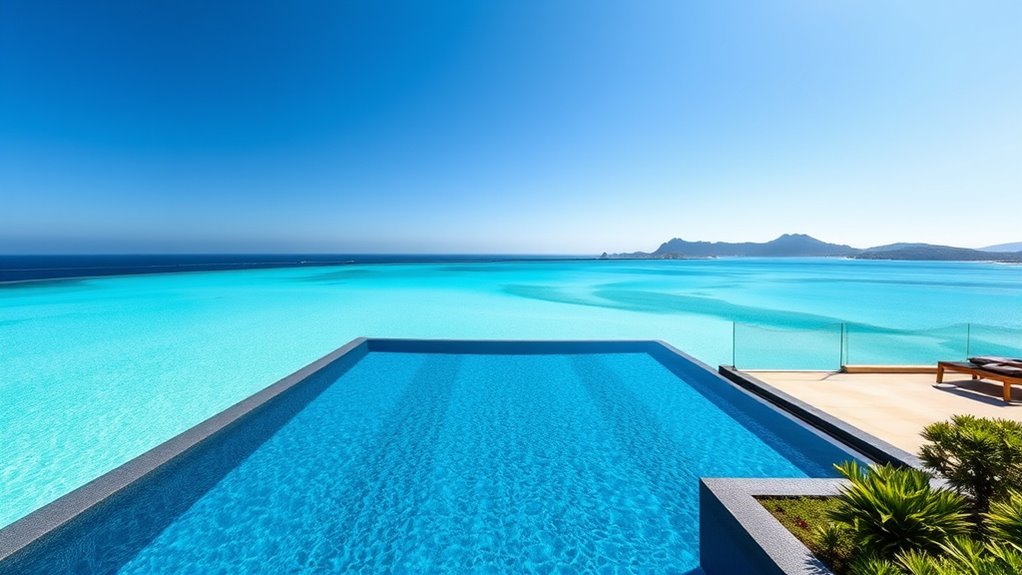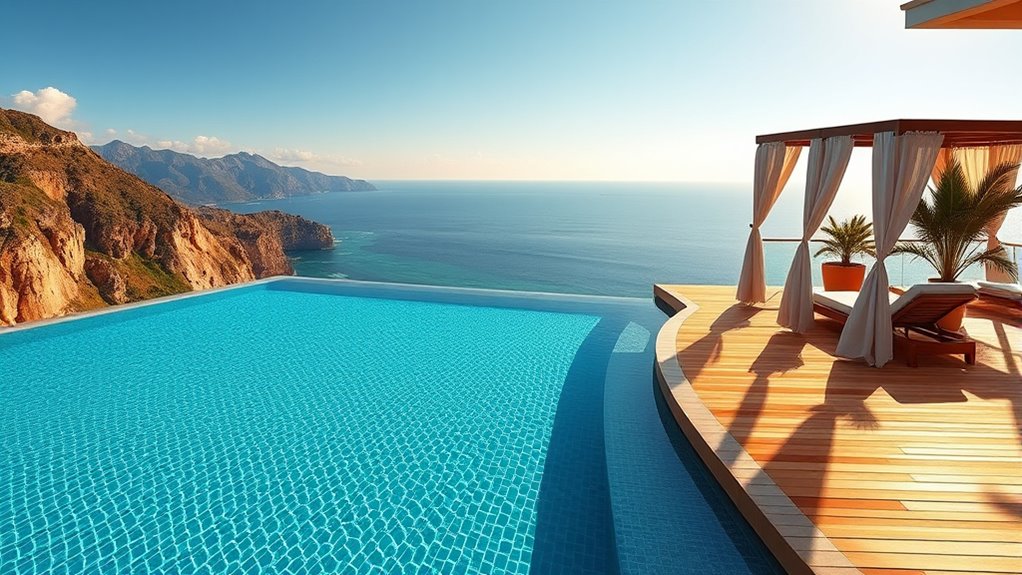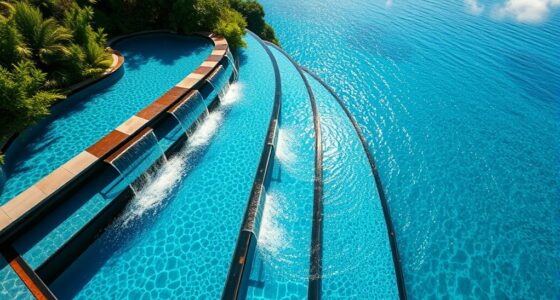An infinity pool costs between $40,000 and over $150,000, depending on size, materials, and location. Smaller pools with basic features tend to be less expensive, while larger, custom-designed pools with high-end materials can raise costs markedly. The complexity of installation, additional features like lighting or heating, and site preparation also influence the price. If you keep exploring, you’ll discover all the details behind these costs and what you should consider when planning your own infinity pool.
How Much Does an Infinity Pool Cost? Complete Breakdown

Are infinity pools worth the investment considering their high costs? It’s a question many homeowners ask before diving into such a luxurious project. Infinity pools, also known as vanishing edge pools, create that stunning illusion of water seamlessly merging with the horizon. While they offer incredible aesthetic appeal and a sense of exclusivity, they come with hefty price tags. The initial costs can seem overwhelming, but understanding what influences the price helps you decide if it’s a worthwhile expense for your property.
The biggest factor influencing the cost is size. A small plunge pool might start around $50,000, but as you increase dimensions, costs rise sharply. A larger infinity pool can easily surpass $100,000 or more, especially when you factor in additional features. The shape and complexity of your design also matter; custom shapes or intricate layouts require more labor and materials, pushing costs higher. Straightforward rectangular pools are generally less expensive than those with elaborate curves or multiple levels.
Material choice plays a significant role in your budget as well. Premium finishes like natural stone or high-end tiles will increase overall costs compared to standard concrete or vinyl liners. The choice of the pool’s structure—whether built-in or freeform—also impacts expenses. Built-in pools might require more groundwork and structural reinforcement, adding to the total. You’ll also need to consider the quality of the materials used for the edge itself, since the vanishing edge must be precisely constructed to achieve that seamless look.
Beyond the pool shell, the costs for the surrounding deck and landscaping can be substantial. Many homeowners want a sleek, integrated look with natural stone or high-end decking materials, which can add thousands to the total. The budget should also include the cost of advanced filtration systems, energy-efficient pumps, and lighting to keep the pool functioning smoothly and looking stunning at night. Maintenance equipment, such as robotic cleaners or chemical treatments, add ongoing expenses that should be part of your long-term financial planning.
Finally, don’t forget the installation costs. Labor for constructing an infinity pool is specialized and often more expensive than traditional pools. It requires skilled craftsmanship to ensure the edge and water flow are perfectly calibrated. Local regulations and permits may also add to your costs, depending on where you live. All these factors combine to create a wide range of potential expenses, making it crucial to establish a realistic budget and work closely with experienced professionals. While the price tag can be high, many find that the unparalleled beauty and luxury of an infinity pool justify the investment.
Frequently Asked Questions
What Are the Ongoing Maintenance Costs for an Infinity Pool?
You’ll typically spend around $1,500 to $4,000 annually on maintenance for your infinity pool. This includes regular cleaning, chemical balancing, and routine inspections. You’ll also need to budget for occasional repairs or equipment replacements, like pumps or filters. Proper upkeep guarantees your pool stays pristine and safe. Staying consistent with maintenance can help prevent costly repairs down the line, keeping your infinity pool a stunning feature of your home.
How Long Does It Typically Take to Build an Infinity Pool?
Building an infinity pool typically takes around 8 to 12 weeks, depending on factors like size, design complexity, and your location. You’ll work closely with contractors who handle excavation, plumbing, and finishing. Delays can happen due to weather or permitting issues, but with clear communication, you can stay on track. Expect the process to include planning, construction, and finishing touches, all aiming to create that seamless, stunning edge you’re envisioning.
Are There Specific Locations Best Suited for Infinity Pools?
Yes, certain locations are better suited for infinity pools. You should choose sites with stunning views like cliffs, mountains, or waterfronts to maximize the visual effect. Elevated areas or properties overlooking the ocean or cityscape work best. Make sure the location has proper drainage and access for construction. Picking a spot with minimal shade and consistent sunlight enhances the pool’s appeal, creating a luxurious, seamless experience that blends into the surrounding scenery.
What Are the Energy Costs Associated With Operating an Infinity Pool?
Think of your infinity pool as a shimmering mirror that demands constant energy to stay in perfect harmony. Operating it, you’ll likely spend $50 to $200 monthly on electricity, depending on size and climate. Pumps and heaters work tirelessly, like a dedicated orchestra, ensuring water stays crystal clear and warm. While costs can seem like a small ripple, they add up, so choosing energy-efficient equipment can help keep your pool’s symphony sustainable.
Can an Infinity Pool Be Added to an Existing Property?
Yes, you can add an infinity pool to an existing property, but it requires careful planning. You’ll need to evaluate your space, structural support, and access for construction. Hiring experienced professionals ensures proper design, permits, and integration with your landscape. Keep in mind, adding an infinity edge may involve significant excavation and reinforcement work, but with proper planning, you can enjoy this stunning feature without major disruptions.
Conclusion
Building an infinity pool is like crafting a masterpiece—you get what you pay for. Just last summer, a friend’s backyard transformation cost around $80,000, turning their space into a resort-like retreat. Remember, costs vary based on size, materials, and features. By understanding these factors, you can budget wisely and create a stunning focal point that’s worth every penny. After all, investing in your dream pool is like planting a seed that blooms into endless relaxation.









